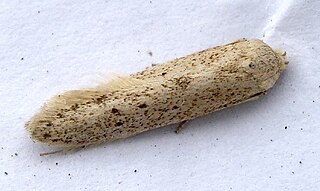
The Blastobasidae are a family of moths in the superfamily Gelechioidea. Its species can be found almost anywhere in the world, though in some places they are not native but introduced by humans. In some arrangements, these moths are included in the case-bearer family (Coleophoridae) as subfamily Blastobasinae. The Symmocidae are sometimes included in the Blastobasidae as subfamily or tribe.

Blastobasis is the type genus of the gelechioid moth family Blastobasidae; in some arrangements these are placed in the case-bearer family (Coleophoridae) as a subfamily. Within the Blastobasidae, the subfamily Blastobasinae has been established to distinguish the Blastobasis lineage from the group around Holcocera, but the delimitation is not yet well-resolved.

Islands, such as the British Isles, can be adversely affected by the introduction of non-native species. Often an island will have several distinct species not present on the nearest mainland, and vice versa. The native flora and fauna of islands which have been isolated for a longer period of time such as New Zealand or Hawaii are more vulnerable than islands such as Great Britain and Ireland, which became isolated more recently.
Blastobasis anthoptera is a moth of the family Blastobasidae. It is found in Australia and New Guinea.
Blastobasis homadelpha is a moth of the family Blastobasidae. It is found in Australia and Samoa.
Blastobasis leucotoxa is a moth of the family Blastobasidae. It is found in Australia.
Blastobasis monozona is a moth of the family Blastobasidae. It is found in Australia.
Blastobasis nephelias is a moth of the family Blastobasidae. It is found in Australia.
Blastobasis pentasticta is a moth of the family Blastobasidae. It is found in Australia, including New South Wales.
Blastobasis phaeopasta is a moth of the family Blastobasidae. It is found in Australia, including northern Queensland. It was first described in 1947 by Alfred Jefferis Turner, and the species epithet, phaeopasta, describes it as being "darkly sprinkled".
Blastobasis tanyptera is a moth of the family Blastobasidae. It is found in Australia, including northern Queensland.

Blastobasis glandulella is a species of moth of the family Blastobasidae. It is found in the Eastern United States and southern Ontario, Canada. It has also been recorded in California. In Europe, it has been recorded from Austria, Germany, the Czech Republic, Italy, Slovakia and Croatia.
Blastobasis aynekiella is a moth in the family Blastobasidae. It is found in Kenya. The habitat consists of the western highlands of the Kakamega Forest.
Blastobasis elgonae is a moth in the family Blastobasidae. It is found in Kenya, where it is known from Mount Elgon in the western highlands.
Blastobasis byrsodepta is a moth in the family Blastobasidae. It is found in South Africa and the Democratic Republic of Congo.
Blastobasis centralasiae is a moth in the family Blastobasidae. It is found in Central Asia and the southern part of European Russia.
Blastobasis ponticella is a moth in the family Blastobasidae. It is found in the north-western Caucasus, Transcaucasia, Crimea and the southern part of European Russia.
Blastobasis desertarum is a moth in the family Blastobasidae. It is found on Madeira and the Azores. The species was recorded from greenhouses in Berlin in 2005, where it was incidentally introduced.

Blastobasis marmorosella is a moth in the family Blastobasidae. It is found on the Canary Islands, Madeira and in Portugal and Spain. This species has been accidentally introduced to Australia and New Zealand.






